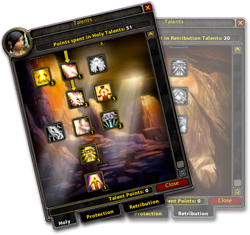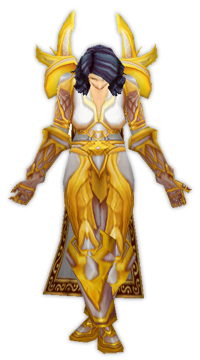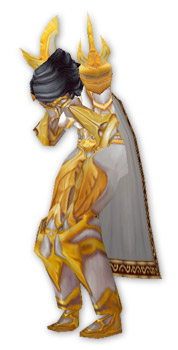This is something I’ve been pondering for months: why WoW is going to be so hard to knock off its pedestal as the premier MMORPG. There are a number of factors involved, but there’s one I haven’t seen anyone else mention, so here we go:
0. Blizzard Are Just Good
Diablo was still in the top 20 selling PC games of 2008, a decade after release.
1. Status Quo
WoW isn’t just the market leader at the moment, it’s the shark in the wading pool; in April 2008 it had 62.2% of the market. 11.5 million subscribers is a huge number for any new game to beat.
2. Experience

Existing games have found their user base by now, and subscriber numbers aren’t likely to grow radically unless something really surprising happens. The next game to ‘win’ the market is likely to be a new game, and WoW has a four-year head start. Blizzard has a very experienced team; they’ve been at this for four years now.
Similarly experienced publishers don’t have any competing products:
- NCSoft (Lineage, CoX, Guild Wars) flopped with Tabula Rasa;
- Sony Online Entertainment (EQ, EQ2, SWG) have displayed a long history of misreading what customers want, culminating in the way they snatched defeat from the jaws of victory with Star Wars Galaxies and Vanguard;
- Turbine (AC, AC2, DDO, LotRO) have a mixed recent history; D&D Online failed dismally (and really, how do you mess up that license?!), while LotRO was somewhat successful – but far from innovative;
- Funcom (Anarchy Online, AoC) have yet to release an MMO that hasn’t been dogged by near-fatal flaws;
- Mythic (DAoC, WAR) arguably flopped with WAR; it sold 1.2 million copies, but retained only 25% of those players less than three months after release;
(Of course, that’s far from an exhaustive list.)
And, in an almost unbeatable position, WoW itself offers four years’ worth of content – eighty levels of quests, zones and dungeons, plus major chunks of raiding content at 60, 70 and 80. That’s far more than any new game can reasonably expect to offer, but it certainly affects the perceptions of the player base – lack of content has been a common complaint regarding recent releases.

3. The Mac Factor
Unlike most other MMORPGs, WoW runs natively on Macs, which is a significant advantage. Analysts say Apple has anywhere from a 10% share to 21% share of the consumer market, which is a big captive audience with little competition.
4. Community
Leafshine discussed this back in September, and BBB posted about it recently: the massive communities surrounding WoW give it a huge competitive advantage. (No need for me to restate their points; they’re both great posts.)
5. Low Barrier to Entry = Critical Mass
This is the factor that hasn’t really been talked about yet, although it’s related to the previous two points.
WoW is easy to run. It doesn’t have the latest, greatest graphics – especially not in the beginner zones, for new players. It doesn’t require the latest, greatest computer to run it. Anyone who’s interested can pick it up and try it out, and provided your computer was bought, oh, probably some time in the last half-dozen years, you can play WoW — which stands in stark contrast to recent releases like WAR or AoC.
On a PC, WoW requires a minimum of a 1.3 GHz CPU, half a gig of RAM, and a tiny 32MB video card. There aren’t many awesome games you can play when you’ve got a computer that’s five years behind the tech curve — but WoW is one of them.
This means that WoW has been, and is, very accessible to non-gamers. It’s perfectly playable for people with home computers they just used for email and browsing the web; it’s usable for people with laptops they bought for school. This has made it very easy for gamer types to bring their spouses, siblings and friends into the WoW-playing fold – “look, you don’t need a computer as good as mine, just install this trial copy on your laptop and let’s have fun running around Dun Morogh killing troggs!”
I doubt I’m telling you anything you don’t know. I bet that just about anyone reading this can name several people they know who’d never have considered themselves a gamer or bothered with anything beyond Bejewelled or Solitaire until someone got them hooked on WoW.
Not only does this create gamers by expanding the potential market for the game, but it creates critical mass within the game. If you’re looking for an MMO you can easily play with your spouse – who’s never been into computer games, but is willing to humor you – then WoW is the obvious choice. If you’re going to play a game with your preteen son or daughter, WoW will probably run on their computer where Warhammer wouldn’t. (There’s some interesting data on couples and family who play together at the Daedalus Project.)
And this effect, I feel, snowballs. The more people you know playing WoW, the more likely you are to pick it up yourself, and then you become part of the critical mass convincing the next person to pick it up.
This effect would be true of any MMO, of course – but only WoW is accessible enough, hardware-wise, to truly capitalize on it.
 Blizzard have finally released information on the dual specs feature talked about for months. You can read the full Q&A
Blizzard have finally released information on the dual specs feature talked about for months. You can read the full Q&A  Some information has started to trickle out from Blizzard about the way loot will work in the next tier of raid content. Some of it’s what I expected, some of it surprises me.
Some information has started to trickle out from Blizzard about the way loot will work in the next tier of raid content. Some of it’s what I expected, some of it surprises me. (Source:
(Source:  (Sources: these posts from Bornakk:
(Sources: these posts from Bornakk:  A couple of points to note:
A couple of points to note: Just
Just 




